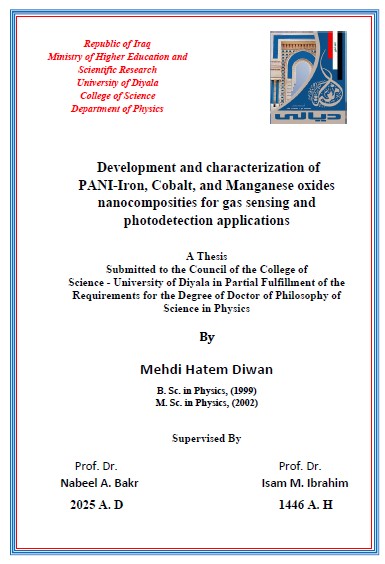Abstract
In this study, polyaniline nanofibers (PAni NFs) and magnetite nanoparticles (Fe3O4 NPs) were synthesized using the hydrothermal technique, while was employed to synthesize tetramanganese oxide nanoparticles (Mn3O4 NPs) and cobalt oxide nanoparticles (Co3O4 NPs) where synthesized via a simple precipitation method. Moreover, PAni NFs and PAni-Metal Oxide (MO) nanocomposite films were prepared using the spin-coating method. Different concentrations of PAni NFs were combined with each type of MO NPs, and the resulting films were deposited on glass as well as on n-type and p-type silicon substrates.
The structural properties using X-ray diffraction confirmed the crystalline nature of PAni NFs and the polycrystalline structures of MO NPs, with the tetrahedral Hausmannite phase for Mn3O4 NPs and the face-centered cubic spinel phase for Co3O4 NPs, as well as the cubic inverse spinal phase for magnetite. In addition, the FE-SEM showed a fiber-like morphology for PAni with diameters of (46–81) nm and a spherical nanoparticle clusters with diameters of (34-53) nm, (20–26) nm, and (58–86) nm for Mn3O4, Co3O4, and Fe3O4 respectively. Additionally, PAni-MO nanocomposites revealed a fiber-like shape coated with nanoparticles have a diameter of (33–53) nm, (33–46) nm, and (27–46) nm for PAni-Mn3O4 nanocomposites, PAni-Co3O4 nanocomposites, and PAni-Fe3O4 nanocomposites respectively.
The UV-Vis spectrum of PAni NFs revealed two absorption peaks at 296 nm and 627 nm, corresponding to π-π* electronic transitions in the benzenoid ring and electron transitions in the polymeric chain from benzenoid to quinoid rings, respectively. However, the shift of peaks toward higher wavelengths for PAni-MO nanocomposites highlighted the decrease in the energy gap in PAni nanocomposites. The FT-IR spectra emphasized the formation of PAni NFs and MO NPs. The red-shifted peak positions in PAni-MO nanocomposites also showed that PAni NFs and MO NPs strongly interacted with each other.
Electrical properties were investigated through D.C and A.C conductivity measurements. However, the D.C. conductivity tests of PAni NFs and PAni-MO nanocomposites films showed that as the temperature increased, the D.C. conductivity increased as well. Moreover, the activation energy calculations confirmed an increase in the D.C. conductivity of PAni nanocomposites with increasing MO NPs content. The A.C. conductivity tests showed an increase in A.C. conductivity for PAni NFs and their nanocomposite films as the frequency increased from (50 Hz to 3 MHz). Additionally, the A.C. conductivity increased as the MO content in PAni nanocomposites increased in comparison to PAni NFs. The dielectric behaviour of PAni NFs and their nanocomposites showed that both the dielectric constant and the loss factor decreased as the frequency increased. The investigations showed that the dielectric constant and the loss factor also increased as the metal oxide content in the polymeric matrix increased.
Hall effect measurements proved that PAni NFs, Co3O4 NPs, and PAni-Co3O4 nanocomposites behaved as p-type semiconductors. In contrast the Mn3O4 NPs and Fe3O4 NPs, as well as the other PAni-Mn3O4 and PAni-Fe3O4 nanocomposites behaved as n-type semiconductors. The C-V characteristics showed that the capacitance decreases as the reverse bias voltage increases for PAni, MO NPs, and PAni-MO heterojunction devices. The capacitance also decreased as the MOs content in the PAni nanocomposite films increased. Moreover, the linear portion of the 1/C2–V plot confirmed the abrupt heterojunction between PAni NFs and their nanocomposite films with p-type and n-type silicon substrates. In addition, the results showed a decrease in the built-in potential (Vb) values with an increase in the MO NPs content within the polymer matrix.
The I-V curves in both dark and light conditions showed that the photocurrent increased as the light intensity and MO NPs in the PAni nanocomposites increased which support the photodiode behaviour. Moreover, the ideality factor values confirmed the non-ideality behaviour of the prepared photodiodes. The I-t curve for each ON/OFF pulse of the prepared heterojunction devices was conducted under various wavelengths (300–500 nm), which revealed an increase in photocurrent with each illumination pulse. Moreover, the results demonstrated an increase in photocurrent as the content of MO NPs in PAni nanocomposites increased.
The gas sensing properties revealed an increase in their sensitivity when exposing the prepared films to NH3 gas. It is clear that the PAni-MO nanocomposites at the concentrations of 5 mL PAni-5 mL Co3O4 and 5 mL PAni-5 mL Fe3O4 have yielded the highest sensitivity values, measuring 20.5% and 18.49%, respectively, compared to the other sensitivity values of the PAni nanocomposite films. Moreover, the results reveal also that the Co3O4 NPs and Fe3O4 NPs films outperformed the other samples, exhibiting the highest sensitivity (646.39%) and (166.36), respectively.





